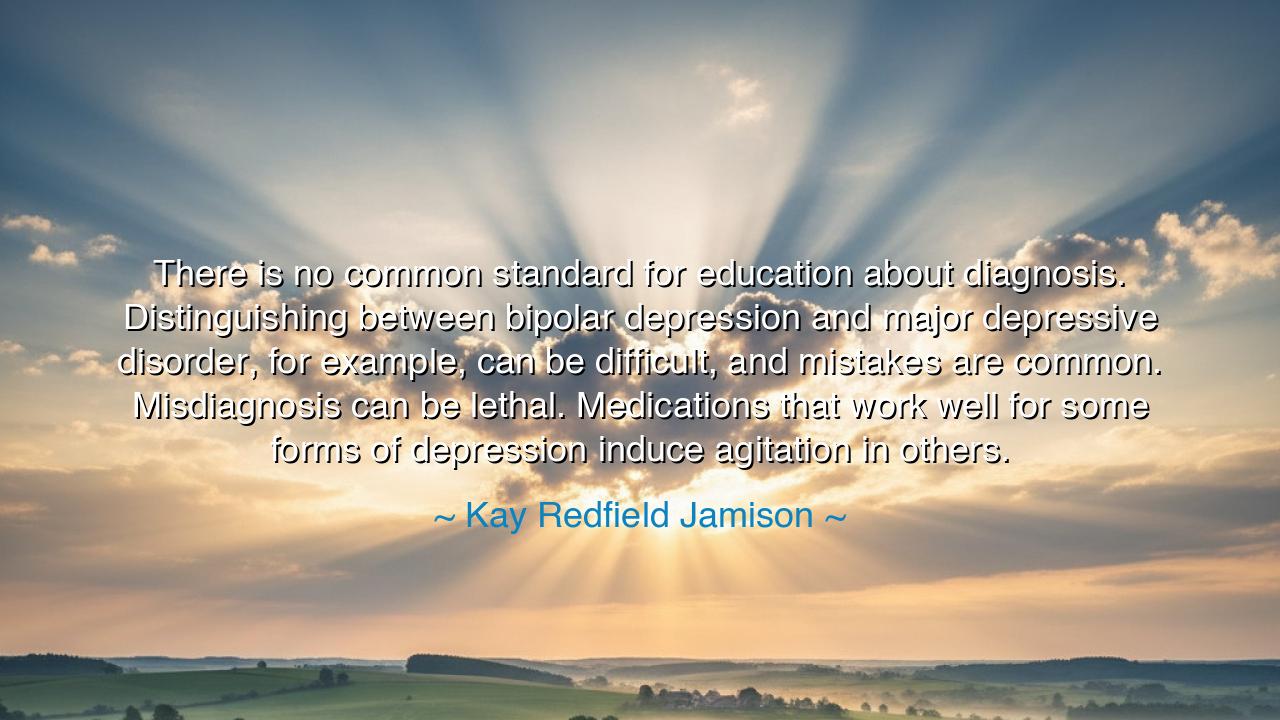
There is no common standard for education about diagnosis.
There is no common standard for education about diagnosis. Distinguishing between bipolar depression and major depressive disorder, for example, can be difficult, and mistakes are common. Misdiagnosis can be lethal. Medications that work well for some forms of depression induce agitation in others.






"There is no common standard for education about diagnosis. Distinguishing between bipolar depression and major depressive disorder, for example, can be difficult, and mistakes are common. Misdiagnosis can be lethal. Medications that work well for some forms of depression induce agitation in others." Thus spoke Kay Redfield Jamison, physician, scholar, and survivor, whose own life has walked through the shadowed valleys of the mind. Her words do not fall lightly, for they spring from both the discipline of medicine and the anguish of lived experience. They call us to remember that the realm of the human spirit is delicate, mysterious, and perilous—and that error in its tending can mean not mere discomfort, but death.
The meaning of this teaching is profound. Diagnosis is the art of naming illness, of drawing boundaries around invisible suffering. Yet, as Jamison reveals, there is no common standard, no perfect compass to guide the healer. Bipolar depression and major depressive disorder, though similar in appearance, are not the same in essence. To confuse them is to risk prescribing treatments that may soothe one soul but inflame another. The sword of medicine, if wielded without precision, may heal or may wound.
History bears grim witness to the cost of such mistakes. In ages past, the melancholic were thought to be possessed, chained, or bled, their suffering only worsened by ignorance. Even in more recent times, before the distinctions of psychiatry were sharpened, countless men and women were misdiagnosed, given treatments that deepened their torment rather than lifting it. The asylum became not a sanctuary, but a prison, where misunderstanding was as deadly as neglect. Jamison’s words remind us that misdiagnosis can be lethal, not in metaphor but in hard reality.
Yet there are also stories of triumph when discernment was rightly applied. Consider the case of John Cade, the Australian doctor who discovered lithium’s effect on bipolar disorder. Before him, many who suffered were cast into despair by treatments that could not help them. But Cade, by careful observation and patient testing, uncovered a medicine that calmed storms without sparking new ones. His discovery, born from wisdom and perseverance, saved uncounted lives. This is the power of correct diagnosis, the gift of knowledge applied with care.
Jamison’s warning, however, goes beyond medicine. It is also a parable about knowledge and discernment in all things. In every field, the failure to distinguish one thing from another, the haste to treat without understanding, leads to harm. Just as the physician must not confuse one form of depression with another, so too the teacher must not confuse curiosity with rebellion, nor the leader confuse silence with consent. Wisdom lies in careful seeing, in resisting the temptation to judge too quickly, in honoring the complexity of human souls.
The lesson is clear: to heal, to guide, to teach—one must first understand. If you are entrusted with another’s well-being, whether of body, mind, or spirit, take care. Do not rely only on surface appearances. Ask, listen, and study until you discern the truth beneath. Remember always that what helps one may harm another, and that compassion without knowledge, though well-meaning, can still destroy. True love is careful; true wisdom is precise.
Practical action follows. Support education that deepens knowledge of the human mind. Demand systems where doctors, teachers, and leaders are trained to see distinctions clearly. If you walk with someone in pain, do not assume; listen deeply before you act. If you suffer yourself, seek second opinions, seek wisdom, and never believe that one approach fits all. In every part of life, remember that precision saves, while assumption destroys.
So I say to you, children of tomorrow: heed the words of Kay Redfield Jamison. The mind is a garden of infinite intricacy, and careless hands can tear up the roots while seeking to pluck the weeds. Be patient, be wise, be humble before its mysteries. For in careful discernment lies healing, and in healing lies hope—not only for the afflicted, but for all who share in the fragile, radiant gift of being human.






AAdministratorAdministrator
Welcome, honored guests. Please leave a comment, we will respond soon